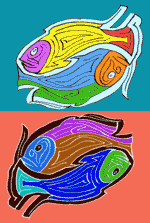|
Theory of the Divided Dream
When I was about thirteen a Serialist philosopher told me to keep a dream diary. A teacher brought in a friend who was a follower of Dunne, the founder of Serialism, according to which we progress on death to a world of four dimensions, and next to five, and on. The fourth dimension being time, in that world we can look back over the whole of time; and we sometimes slip into that next world while dreaming; so evidence for this theory is provided by pre-cognitive dreams, which the Serialist therefore urged us to record. I was probably the only kid who tried to do so. After a while I found myself remembering so much dream that it could take me all day to write, so I did it only sometimes — most usually when I noticed something about what I called “meta-dreaming,” such as dreams within dreams or dreaming about the nature of dreaming. I only ever noticed one that could be called precognitive: a friend had shaved off half of his red beard. Next day, he had, but it was the upper half, not the left half.
But I noticed many other things (some of which I had to revise later) — that there is in dreaming no real death and no consummated sex, that seeking never finds, that dreaming is a plausible origin of religion, that dreams are far too abundant and various for any of them to have “meaning,” that pronouns — identities — freely change, observed becomes observer, thought becomes voice becomes movie, that the richest dreams are caused by heat, that there is no line between dreaming and waking and dreaming by day. And especially I noticed divided dreams: it seemed that the mind may sometimes be dreaming more than one dream simultaneously. The evidence was written dreams in which two — or more — lines of narrative flow together, or diverge. I go along a corridor, turn in to a room. But another part of the narrative tells that I go along the same corridor and out into the open. It would be more economical to narrate the going along the corridor only once, and say that from there the dream split. The waking mind looks back over the dream and tries to narrate it — the very act of remembering is an act of narration — which reduces the dream to a sequence of words, which of necessity is in linear order. The waking mind is a daytime landscape, you can see all over it at once, but the sleeping mind is a dark forest with scattered campfires, the chambers of the mind.
Could this be more than a simile, could there be separated centers of consciousness? It might shed light on the organization of the brain. So, later, I began to question people who knew something about brain physiology. For my specimen Divided Dreams I drew diagrams of their paths, or tunnels. In some cases, a tunnel forked; in others, two tunnels converged; there were instances of forking into three. Another possibility was that two dreams ran parallel, without touching either by convergence or divergence. And two dreams might both run to the moment of waking, like two tunnels emerging from a hillside. This would account for some of the times when one remembers several dreams but cannot decide which came first. This suggested a method of proof. A subject lies sleeping while an experimenter watches. The subject wakes and recounts two dreams, from both of which he remembers waking. But the experimenter has observed that he woke only once.
BACK
|

